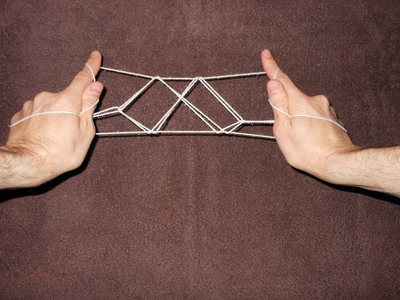
LLX > Neil Parker > String Figures > Odds & Ends

This figure from the Maoris of New Zealand is essentially a continuation of [Jayne 1906]'s "Circles and Triangles." The continuation produces the figure that Circles and Triangles is trying to be.
These instructions are from [Andersen 1927], figure 13 ("Koura (Crayfish)"). This particular variant is called Kotiro-Punarua - a name Andersen doesn't translate, but it seems to mean something like "a pair of girls."
1. Opening A.
2. Pass thumbs over index loops and under little finger loops. Return with both strings of little finger loops.
3. Insert indexes into thumb loops from below, and return with far thumb strings (not the palmar strings). Release thumb loops.
4. Insert thumbs from below into lower index loops, and press them against upper near index strings, so that upper index loops are unable to slip. Bending indexes toward each other, let lower index loops slip off indexes, past upper loops. Extend gently, letting the strings hang somewhat loose.
5. Twist little finger loops a full twist toward you. (This must be done carefully to avoid dropping the little finger loops or pulling the strings too tight.)
6. With fingers pointing downward, rest the figure on your lap or a table, and withdraw all fingers.
7. Insert index, middle, ring, and little fingers down into near (former little finger) loops, and thumbs down into far (former index) loops, and pick the figure back up.
8. With thumbs pressed tightly against indexes to hold far thumb and near index strings in place, insert indexes from above into thumb loops, and return with near thumb strings. Keeping these strings near tips of indexes, extend with palms facing away from you.
Some manual adjustment of the strings may be necessary to enlarge the two central diamonds.
To dissolve the figure without knots, lay it down, and locate the lower left side of the left diamond, and the lower right side of the right diamond. There are two strings on each side, one in front of the figure, and one in back. With thumbs and indexes, grab the front strings, and pull them apart from each other.
Though the steps differ somewhat from those of Circles and Triangles, the result after step 4 is the same, except for the missing half-twist in the near loops (which are held on the indexes instead of the thumbs).
I find it easier to replace steps 4 through 7 as follows:
4. Insert thumbs from below into both index loops. Release upper loops from indexes, catching them on thumbs, and withdraw thumbs back down through remaining index loops, keeping their new loops still on their tips.
5. Twist little finger loops a full twist toward you.
6. Release index loops. Extend gently, letting strings hang somewhat loose.
7. Insert index, middle, and ring fingers from below into little finger loops.
For a very similar figure (but with different string crossings), see the Australian Two Rats Sitting Side by Side.